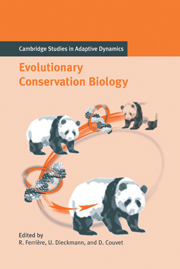Book contents
- Frontmatter
- Contents
- Contributing Authors
- Acknowledgments
- Notational Standards
- 1 Introduction
- Part A Theory of Extinction
- 2 From Individual Interactions to Population Viability
- 3 Age Structure, Mating System, and Population Viability
- 4 Spatial Dimensions of Population Viability
- Part B The Pace of Adaptive Responses to Environmental Change
- Part C Genetic and Ecological Bases of Adaptive Responses
- Part D Spatial Structure
- Part E Community Structure
- References
- Index
- The International Institute for Applied Systems Analysis
2 - From Individual Interactions to Population Viability
Published online by Cambridge University Press: 15 August 2009
- Frontmatter
- Contents
- Contributing Authors
- Acknowledgments
- Notational Standards
- 1 Introduction
- Part A Theory of Extinction
- 2 From Individual Interactions to Population Viability
- 3 Age Structure, Mating System, and Population Viability
- 4 Spatial Dimensions of Population Viability
- Part B The Pace of Adaptive Responses to Environmental Change
- Part C Genetic and Ecological Bases of Adaptive Responses
- Part D Spatial Structure
- Part E Community Structure
- References
- Index
- The International Institute for Applied Systems Analysis
Summary
Introduction
Early life in temporary ponds may be tough for many larval anurans. At extremely high densities, all the tadpoles develop slowly enough, in effect because of food limitation, for them to be driven to extinction. At intermediate tadpole densities, predators like salamanders can have a significant impact on small tadpoles and exert strong selective pressures for faster individual growth. At very low tadpole densities yet another aspect comes into play: predatory salamanders have no appreciable impact because tadpole growth rates are high (resources are plentiful) and encounter rates are low because of both contact probabilities and the availability of refuges.
This classic example of density-dependent selection, demonstrated by Wilbur (1984) and Travis (1984), is instructive in several respects. First, it shows that the risk of extinction of these amphibians depends on their density in a nontrivial way. At high density, regulatory mechanisms become so strong that they may result in population extinction. At very low density, the predation risk is relaxed, which facilitates persistence. At intermediate density, the population undergoes strong selective pressures on those traits for which the adaptive changes feed back onto population density, and thereby influence the risk of extinction. This fascinating case makes it plain that regulatory mechanisms that emanate from individual interactions need to be understood to anticipate the impact of environmental change and evolutionary responses on population persistence.
- Type
- Chapter
- Information
- Evolutionary Conservation Biology , pp. 19 - 40Publisher: Cambridge University PressPrint publication year: 2004
- 6
- Cited by

